
Donald Henry Rumsfeld was an American politician, government official and businessman who served as secretary of defense from 1975 to 1977 under president Gerald Ford, and again from 2001 to 2006 under President George W. Bush. He was both the youngest and the oldest secretary of defense. Additionally, Rumsfeld was a four-term U.S. Congressman from Illinois (1963–1969), director of the Office of Economic Opportunity (1969–1970), counselor to the president (1969–1973), the U.S. Representative to NATO (1973–1974), and the White House Chief of Staff (1974–1975). Between his terms as secretary of defense, he served as the CEO and chairman of several companies.

The National War College (NWC) of the United States is a school in the National Defense University. It is housed in Roosevelt Hall on Fort Lesley J. McNair, Washington, D.C., the third-oldest Army post still active.
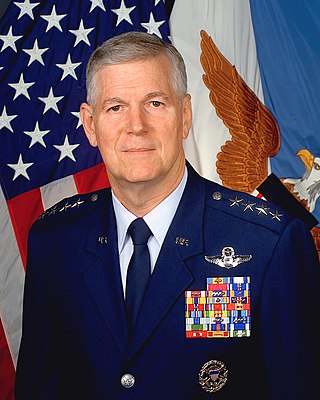
Richard Bowman Myers is a retired United States Air Force general who served as the 15th chairman of the Joint Chiefs of Staff. As chairman, Myers was the highest ranking uniformed officer of the United States military forces. He also served as the 14th president of Kansas State University from 2016 to 2022.
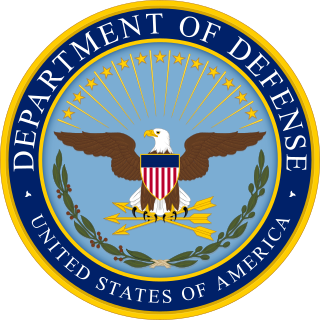
The United States Secretary of Defense (SecDef) is the head of the United States Department of Defense, the executive department of the U.S. Armed Forces, and is a high-ranking member of the federal cabinet. The secretary of defense's position of command and authority over the military is second only to that of the president of the United States, who is the commander-in-chief. This position corresponds to what is generally known as a defense minister in many other countries. The secretary of defense is appointed by the president with the advice and consent of the Senate, and is by custom a member of the Cabinet and by law a member of the National Security Council.
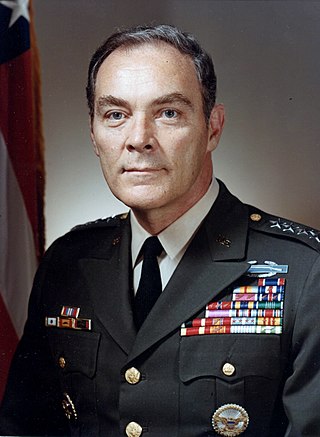
Alexander Meigs Haig Jr. was United States Secretary of State under president Ronald Reagan and White House chief of staff under presidents Richard Nixon and Gerald Ford. Prior to and in between these cabinet-level positions, he was a general in the U.S. Army, serving first as the vice chief of staff of the Army and then as Supreme Allied Commander Europe. In 1973, Haig became the youngest four-star general in the Army's history.

A commander-in-chief or supreme commander is the person who exercises supreme command and control over an armed force or a military branch. As a technical term, it refers to military competencies that reside in a country's executive leadership, a head of state, head of government, or other designated government official.
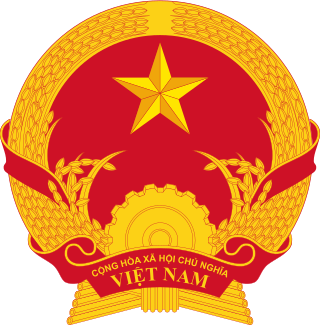
The president of the Socialist Republic of Vietnam is the head of state of Vietnam, elected by the National Assembly of Vietnam from its delegates. Since Vietnam is a one-party state, candidates for the post are nominated by the Central Committee of the Communist Party of Vietnam. The officeholder is generally considered to hold the second-highest position in the political system, practically after the General Secretary of the Communist Party of Vietnam.

The United States Indo-Pacific Command (USINDOPACOM) is the unified combatant command of the United States Armed Forces responsible for the Indo-Pacific region.

The Naval Postgraduate School (NPS) is a public graduate school operated by the United States Navy and located in Monterey, California.

The Bear and the Dragon is a techno-thriller novel, written by Tom Clancy and released on August 21, 2000. A direct sequel to Executive Orders (1996), President Jack Ryan deals with a war between Russia and China, referred respectively in the title as the Russian Bear and the Chinese Dragon. At over 1,028 pages, it is Clancy's longest novel. The book debuted at number one on The New York Times Best Seller list.

The Air Force Reserve Officers' Training Corps (AFROTC) is one of the three primary commissioning sources for officers in the United States Air Force and United States Space Force, the other two being the United States Air Force Academy (USAFA) and Air Force Officer Training School (OTS). A subordinate command of the Air University within the Air Education and Training Command (AETC), AFROTC is aligned under the Jeanne M. Holm Center for Officer Accessions and Citizen Development at Maxwell AFB, Alabama. The Holm Center, formerly known as the Air Force Officer Accession and Training Schools (AFOATS), retains direct responsibility for both AFROTC and OTS.
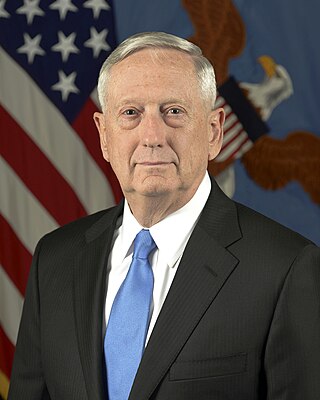
James Norman Mattis is an American military veteran who served as the 26th United States secretary of defense from 2017 to 2019. A retired Marine Corps four-star general, he commanded forces in the Persian Gulf War, the War in Afghanistan, and the Iraq War.
A unified combatant command, also referred to as a combatant command (CCMD), is a joint military command of the United States Department of Defense that is composed of units from two or more service branches of the United States Armed Forces, and conducts broad and continuing missions. There are currently 11 unified combatant commands, and each is established as the highest echelon of military commands, in order to provide effective command and control of all U.S. military forces, regardless of branch of service, during peace or during war time. Unified combatant commands are organized either on a geographical basis or on a functional basis, e.g., special operations, force projection, transport, and cybersecurity. Currently, seven combatant commands are designated as geographical, and four are designated as functional. Unified combatant commands are "joint" commands and have specific badges denoting their affiliation.

Lloyd James Austin III is a retired United States Army four-star general who has served as the 28th and current United States secretary of defense since January 22, 2021.
In the United States Armed Forces, a lieutenant general is a three-star general officer in the United States Army, Marine Corps, Air Force, and Space Force.

The Director of the National Security Agency (DIRNSA) is the highest-ranking official of the National Security Agency, which is a defense agency within the U.S. Department of Defense. The director of the NSA also concurrently serves as the chief of the Central Security Service (CHCSS) and as the commander of U.S. Cyber Command (USCYBERCOM). As the director of the NSA and the chief of the CSC, the officeholder reports to the under secretary of defense for intelligence, and as the commander of U.S. Cyber Command, the officeholder reports directly to the secretary of defense.

The United States Department of Defense is an executive branch department of the federal government of the United States charged with coordinating and supervising all agencies and functions of the U.S. government directly related to national security and the United States Armed Forces. As of June 2022, the U.S. Department of Defense is the largest employer in the world, with over 1.34 million active-duty service members, including soldiers, marines, sailors, airmen, and guardians. The Department of Defense also maintains over 778,000 National Guard and reservists, and over 747,000 civilians bringing the total to over 2.87 million employees. Headquartered at the Pentagon in Arlington County, Virginia, just outside Washington, D.C., the Department of Defense's stated mission is to provide "the military forces needed to deter war and ensure our nation's security".

The National Security and Defense Council of Ukraine is the coordinating state body of the executive power under the President of Ukraine on issues of national security and defense.
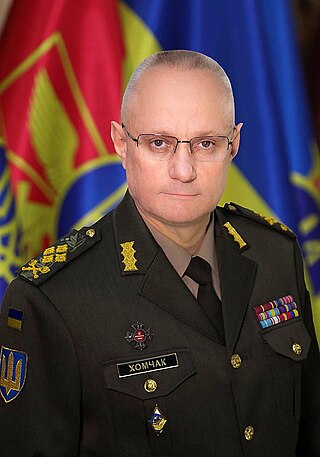
Ruslan Borysovych Khomchak is a Ukrainian Colonel-general who serves as the First Deputy Secretary of the National Security and Defense Council of Ukraine and former Commander-in-Chief of the Armed Forces of Ukraine, until 28 March 2020 also holding the post of Chief of the General Staff.















